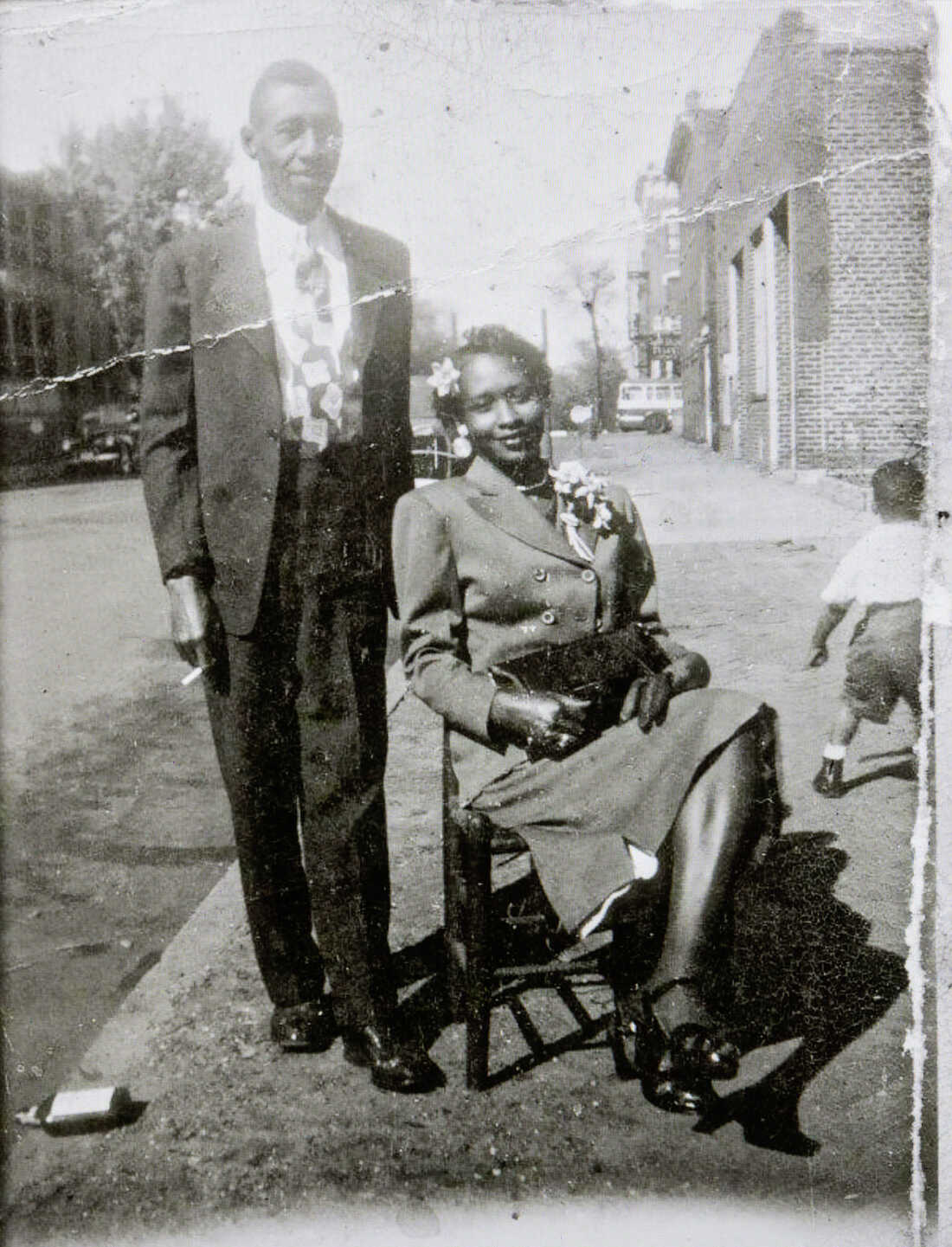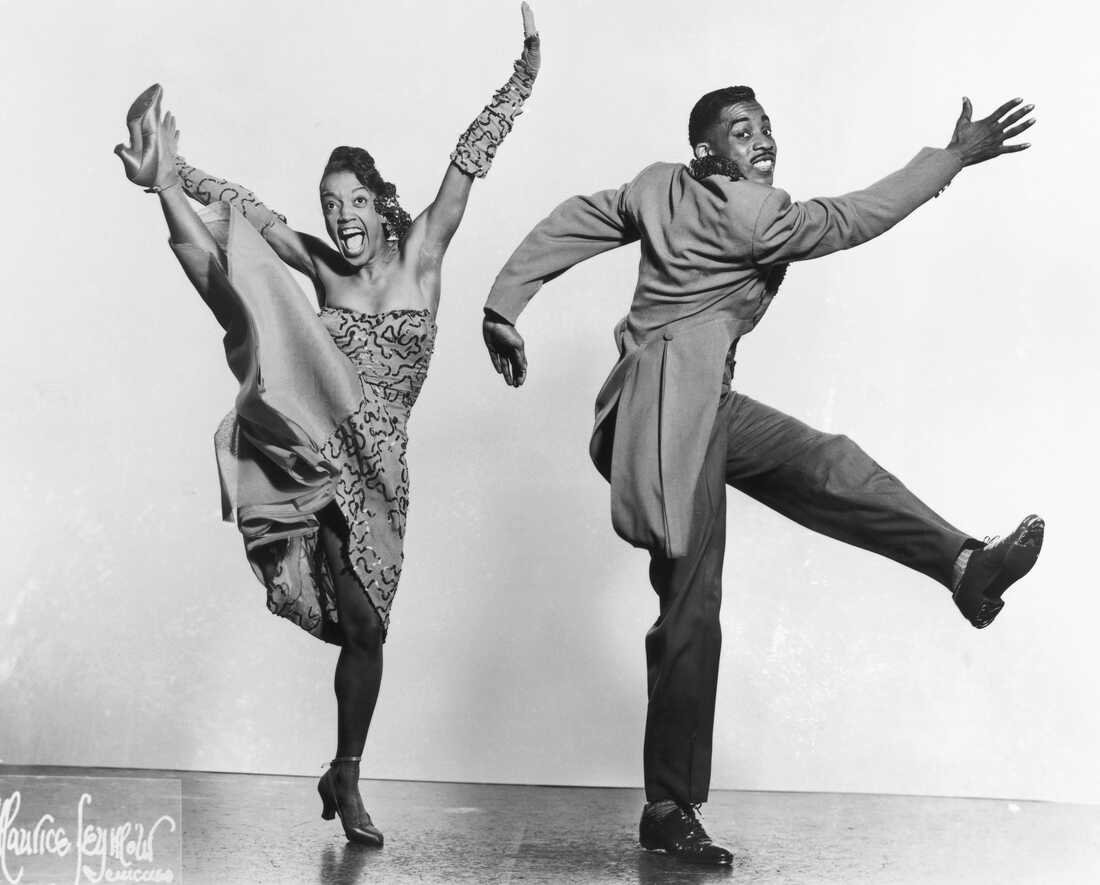
Lindy Hop dancer LaTasha Barnes is upholding the traditions of the dance that originated in Harlem in the 1920s. Cassidy Araiza for NPR
When she thinks about being a tradition-bearer through dance, LaTasha Barnes goes back to her family.
Barnes grew up in a multigenerational household in Winterpock, Va. Her great-grandmother, Elizabeth Harris, was one of the few Black cooks to run her own kitchen in the city of Richmond. At home in the farmhouse, she'd often cook to the sounds of Louis Armstrong.

A family photo of Barnes's great grandmother, Elizabeth Harris. Cassidy Araiza for NPR
The way Barnes remembers her childhood, there was always music and dancing in the house. Cousins came to visit from Washington, D.C. and New York, bringing the latest dance trends. Barnes grew up watching her parents rehearse their entrances to the social clubs, where they would enter dance contests.
One Sunday afternoon, when she was about 4 years old, her great-grandmother took her hand and led her into a swing out. Barnes still remembers the feeling of being pushed and pulled by her great-grandmother's hand. It was the same "in and out motion" that she saw in the dancing that her aunts and uncles did at parties.
"It was a baseline groove that everybody had. And then I felt like I could see it in their individual movements as well," she said.

Barnes holds a family photo of her dancing with her father, Thomas Barnes. There was always music and dancing in her childhood. Cassidy Araiza for NPR
She now realizes that afternoon with her great-grandmother was the first time she danced Lindy Hop.
Lindy Hop is a jazz dance that originated in Harlem in the 1920s and 1930s and has since gained a following across the world, with large communities in Sweden and South Korea. It's an African American social dance. To Barnes and her great-grandmother, it was just called "fast dancing."
By the time she was 31 years old, Barnes had become a world champion in House, a dance style that surfaced out of underground music clubs in Chicago and New York. As she developed her dance practice, she felt a growing need to understand the jazz roots of the street dances for which she was becoming well-known.
Loading...
"When I first re-encountered Lindy Hop, it was presented as this thing that white people do at weddings," Barnes says. "It wasn't presented as a Black cultural art form."
Barnes wanted to go beyond this perception. She went to the Library of Congress to watch reel-to-reel archival films and worked closely with knowledgeable Lindy Hoppers. This was the beginning of her journey to reconnect with the sense of movement she had experienced while dancing with her great-grandmother.
Her research and dedication led her to the originators of Lindy Hop. In 2016, she was invited to perform with the luminaries–affectionately called the "elders"–of Lindy Hop. Chester Whitmore, Barbara Billups, Sugar Sullivan, and Norma Miller, known as the "Queen of Swing," were all there. Barnes recalls a moment between dances when it suddenly seemed as if all the white dancers had left the room.

American Lindy Hop dancer Norma Miller and her long time dance partner, Billy Ricker, perform in Chicago circa 1940. Known as the "Queen of Swing", Miller later formed her own dance troupe. Michael Ochs Archives/Getty Images
"And I became a magnet somehow. I was just sitting on the couch next to Miss Norma," she said. "And I looked up and she made a gesture. And all of them descended upon me."
It felt like a sign. There was a moment of recognition. And laughter.
"And Chester leaned over to me [and said], "Are you ready? 'Cause you know this is on you now," she said. "And from then on the level of responsibility absolutely shifted."
Barnes remembers this as the night she was declared a tradition-bearer of Lindy Hop by some of the dance's most important practitioners.

Barnes dances with students at Arizona State University in November. Caitlin O'Hara for NPR
This past fall, Barnes joined the faculty of Arizona State University's School of Music, Dance and Theatre, where she mentors young dancers and teaches courses on Black American dance forms and what she calls "the jazz continuum."
When Barnes teaches and performs Lindy Hop today, she says she's reaching for the joy she felt dancing with her great-grandmother. It is in this spirit that she carries the responsibility of being a tradition-bearer of a nearly 100 year-old dance. That's what she brings to the dance floor, whether she's improvising with friends in the studio or performing onstage.
"Each time you make a connection and you make a move happen, just off the basis of being together, it ignites joy," she said. "And just this exchange of energy gives you something to hold onto and something to celebrate."
Loading...
A Lindy Hop Starter Pack
- Here's some of LaTasha's favorite songs to dance to:
- Chicken An' Dumplings (Live), by Art Blakey & The Jazz Messengers
- Lavender Coffin, by Lionel Hampton
- Wailing Interval, by Duke Ellington
- Sister Sadie, by Horace Silver
- Harlem, Harlem, Harlem, by Charles Turner & Uptown Swing
- You Can't Pull the Wool Over My Eyes, by Catherine Russell
- Jersey Bounce, by Ella Fitzgerald
- Pickin' the Cabbage, by Cab Calloway
- Listen to Snatch & Grab It, by Julia Lee.
- Watch the spectacular Lindy Hop sequence in the 1941 film Hellzapoppin.
- Watch Frankie Manning talk in 2006 about his life and career.
- Watch LaTasha and Felix Berghäll dance at the 2019 International Lindy Hop Championships.
- Learn more about the Smithsonian Jazz Oral History Program.
Listen to Rough Translation wherever you get your podcasts, including NPR One, Apple Podcasts, Google Podcasts, Pocket Casts, Spotify, and RSS.
No comments:
Post a Comment